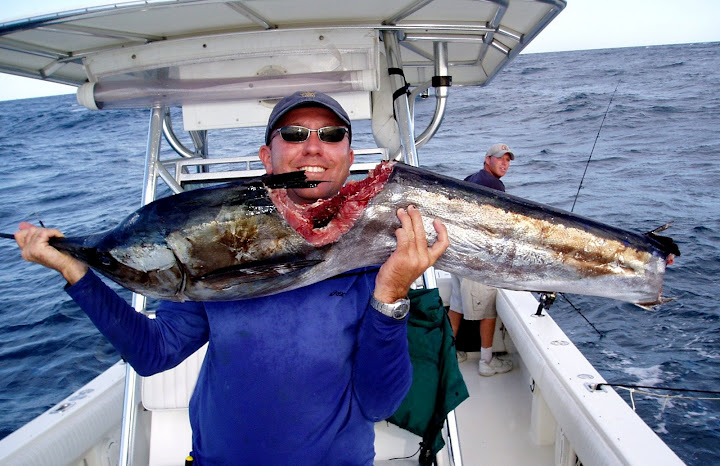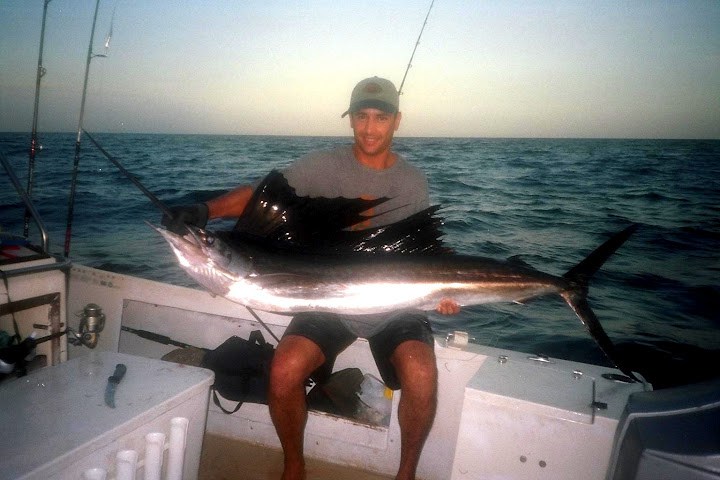The guys I grew up and am still friends with are all avid anglers. As far back as junior high school, we used to skip class and go fishing. We’d load our gear on the back of our bikes and spend the day at our favorite spots around South Miami. We’d be sure to cover up with hats and sunscreen so as not to come home with telltale tans that would get us caught and grounded.
A couple of years ago one of these same buddies told me had never landed a sailfish. We decided to take a day off and remedy this “immediately if not sooner” (an expression we commonly use as a joke). We woke up early, got our gear together and headed out. It was a nice day with just the type of peaked chop that sailfish commonly feed in. This gives them the advantage of being able to sneak up, cut across the wave crests and crash into their prey. We stopped at a spot we knew and were able to use chum and Sabiki rigs (six tiny lures in a row) and procure an assortment of great baits. In this case, we caught big
pilchards, cigar minnows and a few goggle-eyes.
The way we fish is for sailfish is relatively simple. We stop the boat between 80 and 160 feet of water, shut the engine down, turn sideways and put out a sea anchor. This is a large canvas sock tied off to the bow which catches the water and slows the boat’s drift speed. The breeze was out of the east, which would blow us from deep to shallow, so we put out our sea anchor and began our drift in about 160 feet of water.
Our “spread” consisted of two baits on the surface, one mid-water and two near the bottom. We took our places near our rods and started our vigil. We didn’t have to wait long before the surface line nearest me popped off of the copper wire. When sail-fishing, it’s necessary to leave the bail open and the line held in place with a piece of wire. This referred to as “putting it in the copper”. It allows the fish to approach the bait, swat it with its bill,
grab it and eat it while still on the hook. Otherwise the fish will knock your bait off of the hook and eat it, but you will miss your shot at catching it.
I closed the bail, came tight on the fish and off it ran. It did not jump at all, but sounded and began circling the boat. That is typical behavior of a tuna. True to form, it was a black fin tuna in the ten pound range. Not the billfish we
were shooting for, but great table fare none the less. I cut a small slit just behind the gills and ‘bled it’ over the side of the boat. This is done with tunas because they are very bloody fish and to remove some of the lactic acid that has built up in the meat during the fight. Lactic acid degrades the quality of the meat. I washed it off and put it deep into the ice in the cooler. We were glad to have some dinner in the boat.
I re-baited the hook, casted it back out and waited for our next opportunity. A few minutes later, the line on the top water rod nearest to my buddy popped off of the copper and began ripping off of the reel. He gave it a few seconds to run, closed the bail and came tight on the line. It started screaming line off of the reel like a rocket. This was followed by a huge explosion and splash as a beautiful sailfish broke the surface repeatedly.
We were stoked, but focused on making the “hook up” turn into a “catch”. In the fishing world, that is achieved by physically touching the heavier line near the hook known as the leader. The best way to “catch” a big fish on a spinning rod is to put the angler on the bow of the boat and slowly follow the fish with the engine in gear. This avoids
having too much line taken off of the spool. It’s also better for the fish, as it shortens the fight, thereby reducing the stress on it. I ran around the boat and reeled in all of our baits, pulled the sea anchor, started the engine and began the pursuit.
The sailfish was average sized for the Atlantic species, but it fought like a champion. It made several runs, cuts, turns and some more spectacular jumps. I followed the fish with the boat, putting it in and out of gear as the situation
warranted. My buddy had the angling experience to play it perfectly and after about 20 minutes or so, he had the fish alongside the boat.
A couple of high fives and photos later we began the task of reviving the sailfish. This is done by holding the fish in the water by the base of the bill and idling forward slowly. By moving the fish forward through the water, you increase the oxygen going into the gills. After a few minutes, the fish will begin moving, wagging its tail and biting on your hand as you hold it. This is when you know it’s okay to release the fish.
Unfortunately in this case, the fish was not responding like it should have. After taking turns holding the bill and driving the boat for quite some time, we realized
that the sailfish was in real trouble. Passionate anglers learn to respect the fish that they catch, especially ones who put up a great fight. That combined with the fact that this was my friend’s first billfish, made him decide to take
more extreme measures. He found a dive mask, grabbed the fish by the bill and jumped overboard with it.
We idled along while my friend held onto the sail’s bill with one hand and the bow-rail of my boat with the other. As we cruised along I noticed that according the gps, we were coming back into the area where we had landed the tuna in about 160 feet of water. I was thinking that it was good because we would be able to start our next drift from this spot again. Other implications didn’t cross my
mind at the time.
Suddenly my friend, who is one of the most fearless guys I’ve ever known, let out a yell and began walking on the water in an attempt to get into the boat. The trouble
was that he refused to let go of the fish in the process. He was stuck flailing on the bow-rail, half in and half out of the water. He was screaming, “Get us in the boat!!! Get us in the boat!!!” He was holding onto that sailfish as if it was his first born.
It didn’t take a rocket scientist to figure out what was causing my friend distress. I looked down and could see the tail of the fish dangling between his flailing feet and a huge dark shape directly underneath. Instead of trying to get them both out awkwardly, I grabbed the sailfish by the bill, leaned back and fell back into the boat with it on top of me. My friend came flying in over the side and we found ourselves in a tangled mess on the bow of the boat. “Shark! Shark! A big f*#@ing bull shark!” he gasped. “That thing was HUGE! I can’t believe you pulled the fish in and not me!” I just shook my head and said, “It wanted the sailfish! I thought I’d just take it out of the equation. Did you consider just giving it to him?” His response was, “No way man!”
He told me that while he was in the water with the fish, he felt like something was watching him. He looked down to see a ten foot, 500 pound bull shark coming right for him. It was agitated and ‘lit up’ with its pectorals and dorsal fin pointing straight out in an attack posture. There’s no way to know how long the shark had been watching the action and following the sailfish. Possibly, it had been in the area since we bled the tuna. The blood in the water probably hadn’t helped the situation one way or another.
As we feared, the sailfish did not survive the ordeal. We were really bummed out, but we figured that since it did die, we’d at least make use of it. We ended up taking it home and having the meat smoked. It came out excellent and we had plenty to share with friends and family. Not what we wanted, but at least the fish did not go to waste.
After the ordeal, we cleaned up the boat, got ourselves together and put out more lines. We wound up having a stellar day. We caught two more nice tuna, a big kingfish and a sizable mutton snapper. On our final drift we caught another sailfish. This one was released happy and healthy to fight another day.


